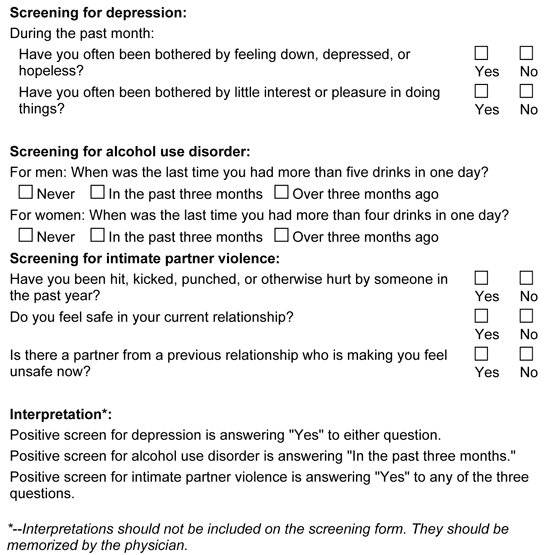
Am Fam Physician. 2004;69(10):2421-2422
A more recent article on the intimate partner violence is available.
Clinical Question
How can physicians most effectively screen their patients for depression, alcohol use disorders, and domestic violence?
Evidence Summary
During routine office visits, primary care physicians are expected to efficiently and effectively screen their patients for common, important conditions. Routine screening for depression is recommended by the U.S. Preventive Services Task Force (USPSTF) as long as systems are in place to ensure accurate diagnosis, effective treatment, and follow-up.1 The USPSTF also recommends screening for problem drinking.2 The evidence regarding screening for domestic violence is insufficient for the USPSTF to make a recommendation,3 but physicians may wish to build screening for domestic violence into their routine care of patients.
Because the typical visit includes three problem conditions and eight care decisions,4 it is a challenge to add these screening tasks. Fortunately, primary care researchers have developed useful and highly practical screening tools that can be administered by physicians or self-administered by patients. These initial screening questions all require confirmation by the physician using a detailed clinical interview or a longer, but more specific, diagnostic instrument. This “Point-of-Care Guide” presents initial screening tools for problem drinking, depression, and domestic violence.
Williams and colleagues developed and validated a single question to screen for problem drinking (see accompanying figure on page 2422).5 The question asks: “When was the last time you had more than X drinks in one day?,” with X being four for women and five for men. The question was tested prospectively in a group of 1,432 men and 1,085 women presenting to an emergency department with an injury. Of this group, 35 percent were problem drinkers, meaning that they were either hazardous drinkers, had a recent alcohol use disorder, or both. The sensitivity and specificity using a cutoff of more than four or five drinks in the past three months were both 86 percent. This means that in a typical population-based sample, 52 percent with a positive response were problem drinkers, compared with only 3 percent who screened negative. Patients checking “Never” have only a 1 percent risk of problem drinking. A positive screen for problem drinking should be followed by a more detailed clinical interview to confirm the diagnosis. The patient also could be asked to complete a more detailed survey instrument such as the Alcohol Use Disorders Identification Test (AUDIT), which is available online at several sites, includinghttp://www.ukalcohol-forum.org/images/audit.pdf.
A two-question initial screening test6 for depression has been developed and validated based on the Diagnostic and Statistical Manual of Mental Disorders, 4th edition, text revision,7 established criteria for the diagnosis of depression (see accompanying figure). A positive response to either question is extremely sensitive and identifies more than 90 percent of patients with major depression. However, it is only approximately 60 percent specific and requires confirmation using a detailed clinical interview or a more specific tool such as the Patient Health Questionnaire (PHQ-9).8 A more detailed interpretation of the two-question screening test also has been validated, although it is somewhat more complex to administer and interpret.9 The full PHQ-9 is available online from the MacArthur Foundation at:http://www.depression-prima-rycare.org/clinicians/toolkits.

One screening test for domestic violence has been recommended that asks the patient a single question: “Do you feel safe at home?” However, this test does not have sufficient sensitivity (10 percent) to serve as a good screening instrument.10 A three-question screen called the Partner Violence Screen11 was reasonably sensitive (71 percent using the conflict Tactics Scale as the reference standard) and had adequate specificity (84 percent) in the emergency department setting.11 This screening test should be considered by physicians who wish to incorporate routine screening for intimate partner violence into their practice. Given an overall prevalence of domestic violence of 29 percent, over one half of patients with a positive screen were victims of domestic violence compared with approximately 12 percent of those with a negative screen.11 Additional research is needed to evaluate these screening instruments in the primary care setting, to determine the best way to administer them, and to evaluate their accuracy against stronger reference standards. Physicians should remain vigilant in screening for domestic violence in patients presenting with injuries, substance abuse, depression, and other related problems.
The accompanying figure shows a suggested set of questions that can be self-administered during an annual health maintenance visit. The physician should review the patient’s answers to these questions during the medical interview. A positive screen requires further investigation by the physician. The physician also may memorize the questions for use in other situations. A framing statement has been added to the Partner Violence Screen because of the sensitivity of the subject and to avoid upsetting patients. The accompanying figure is available online athttps://www.aafp.org/afp/2004/0515/p2421.html.